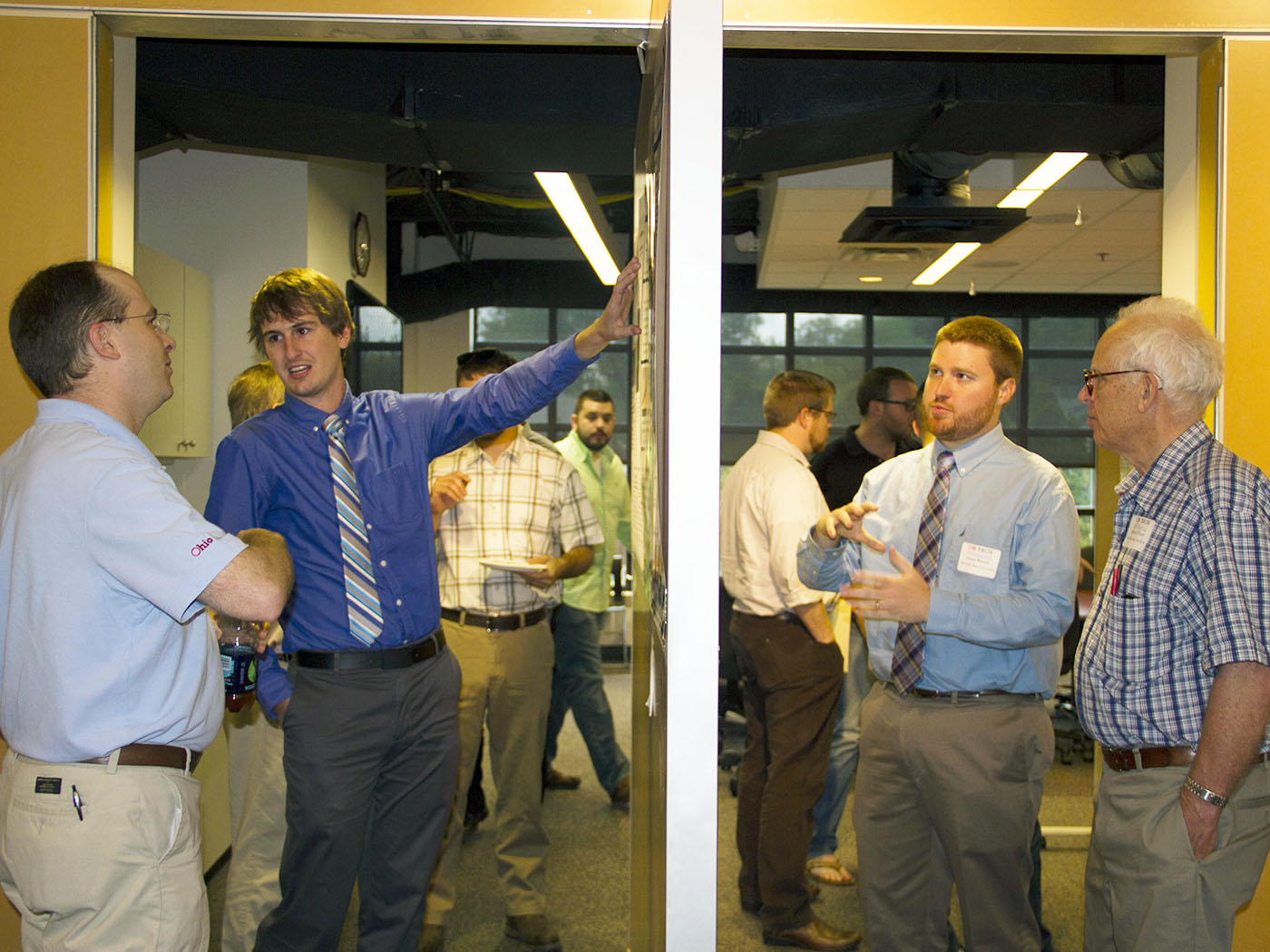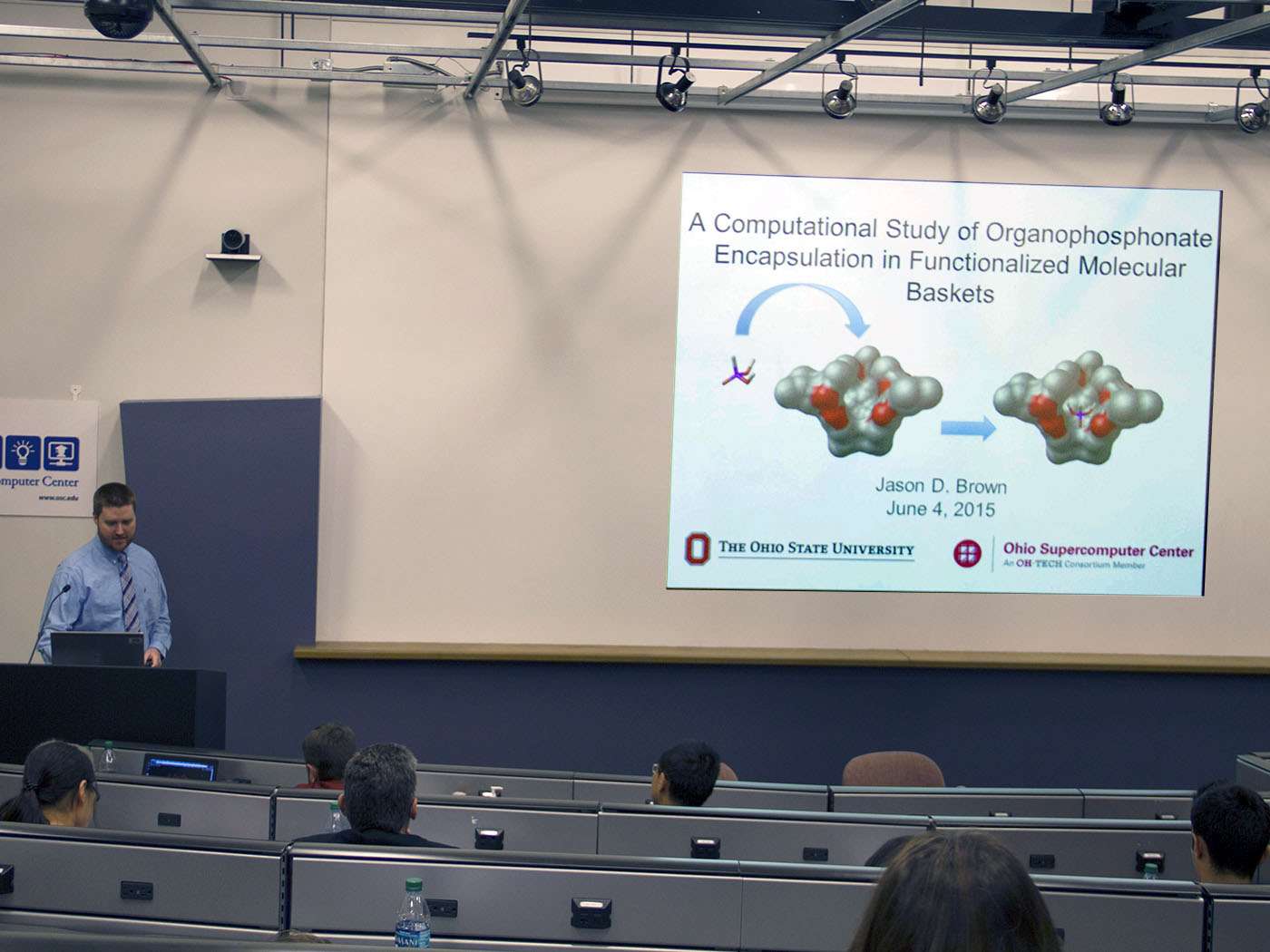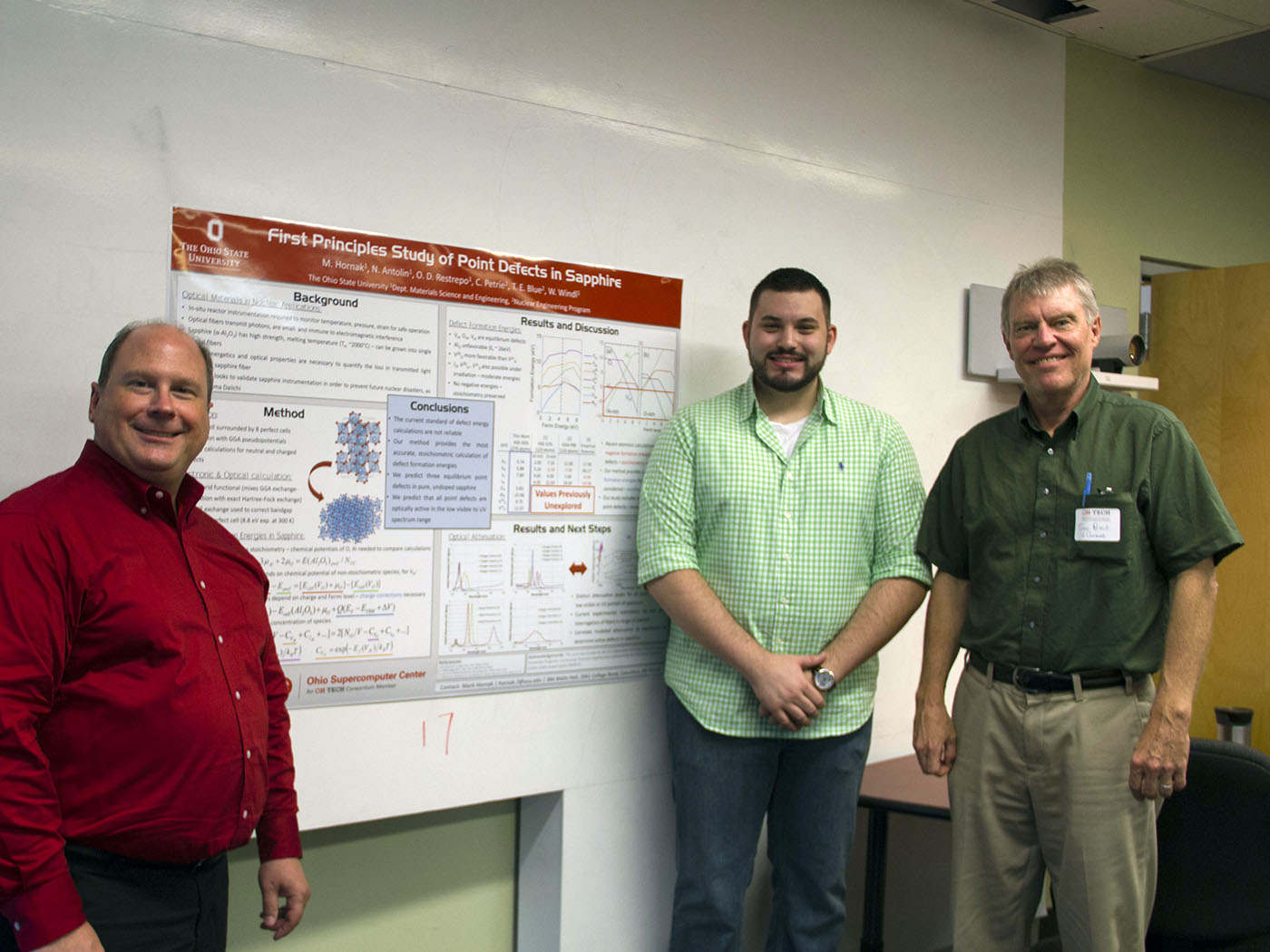Research projects featuring a wide range of scientific interests, such as electron microscopy, pesticides and polymers, were featured at the first-ever poster session and flash talk competition at the Ohio Supercomputer Center (OSC) June 4.
The competition was held during the semi-annual meeting of the Statewide Users Group. SUG is a volunteer group comprised of the scientists and engineers who provide OSC’s executive director with program and policy advice and direction “to ensure a productive environment for research.” SUG was instituted in 1986, a year prior to the creation of OSC, to advise administrators and policy makers on their planning and acquisition activities for the Center.

“We chose to hold these poster and flash talk competitions in conjunction with SUG so that we could highlight even more of the impressive work that is being done on OSC systems,” said David Hudak, Ph.D., director of supercomputing services. “These venues also give SUG and OSC staff members a great opportunity for increased interaction with our younger investigators – graduate students and post-doctoral staff – so that we can better understand their computational successes and challenges.”
Prior to the competitions, Jeff Graham, director of the high performance computing facility in the Air Force Research Laboratory at Wright Patterson Air Force Base, delivered a keynote presentation titled, "AFRL DSRC - Not Just a DoD Supercomputing Resource Center." His talk was followed by another keynote presentation, "Exploring the Dark Side with Simulations," delivered by Annika Peter, Ph.D., an assistant professor in the physics department at The Ohio State University.

Jason Brown of The Ohio State University won first place in flash talk competition, and Bryan Esser, also from Ohio State, took first place in the poster competition. They each were awarded 5,000 resource units of time on OSC supercomputer systems, and their work will be featured in the Center’s annual research report. Second-place winners were awarded 2,500 units of supercomputer time.
Brown spoke on “A Computational Study of Organophosphonate Encapsulation in Functionalized Molecular Baskets” and acknowledged Christopher Hadad, Ph.D., Jovica Badjic, Ph.D., Jeremy Beck, Ph.D., Ryan Yoder, Ph.D., Jeremy Erb, Ph.D., Paul Peterson, Ph.D., and Katharine Cahill, Ph.D. (all of Ohio State). The Defense Threat Reduction Agency and National Institutes of Health funded Brown’s project.
Brown described his work: “Organophosphorus nerve agents (OPs) are a toxic class of compounds that have been used as pesticides and chemical warfare agents, and compounds for which there is a great need of effective therapeutics. Gated molecular baskets conjugated to aliphatic amino acid functionalities have been examined for the binding and hydrolysis of the toxic nerve agent upon entering the bloodstream. A computational protocol was developed for the molecular baskets including a Monte Carlo conformational search, Molecular Dynamics simulations, and docking calculations. The results of the computational studies of the baskets and the critical features for encapsulation of OPs will be presented.”

Esser’s poster featured the project “Understanding Dislocation Core Contrast using Atomic Resolution Electron Microscopy Image Simulation,” a project credited to Esser, as well as Timothy Smith, Maryam Ghazisaeidi, Ph.D., Michael Mills, Ph.D. and David McComb, Ph.D. (all of Ohio State), as well as Easo George, Ph.D., and Frederik Otto, Ph.D. (both of Ruhr University Bochum, Germany). The National Science Foundation funded Esser’s project.
Esser’s abstract read: “Atomic resolution scanning transmission electron microscopy (STEM) is often used to analyze deformation mechanisms and properties. Strong contrast has been observed around dislocation cores using medium-angle annular dark field STEM, but not in high-angle conditions. Atomic resolution image simulations using μSTEM have been employed with atomistic simulations on model FCC alloys to explain the nature of the contrast variation as a function of scattering angles for these HEAs in thin foil geometries necessary for high resolution imaging. Only through the use of HPC, especially with GPU acceleration, can such large systems be reasonably studied."

Xiang Chen, of Ohio State, won second place in the flash talk competition, discussing “Simulations of nanometer-scale inclusion-matrix interactions in shape memory alloys.” Chen credited Peter M. Anderson, Ph.D., of Ohio State as the primary investigator for the project. The Department of Energy and the National Science Foundation funded the project.
Chen described his topic, "This flash talk presents two projects in materials science which utilized the HPC resources at OSC. The first project investigates the transformation-induced dislocation effect in single crystal nickel-titanium shape memory alloy. The driving force profile on different dislocation slip systems are solved through micromechanics, utilizing the large memory node on OSC’s Oakley cluster. The results correlate well with the electron microscope observations. The second project investigates the phase evolution in nano-precipitated Ni-Ti-Hf shape memory alloy through finite-element simulation. The large scale multi-precipitate simulations shed lights on the physical basis underlying the microstructures observed in high-resolution electron microscopy."

Mark Hornak, of Ohio State, placed second in the poster session with his project, “First Principles Study of Point Defects in Sapphire.” The project was credited to Hornak, as well as Nicholas Antolin, Oscar Restrepo, Ph.D., Christian Petrie, Ph.D., Thomas Blue, Ph.D., and Wolfgang Windl, Ph.D. (all of Ohio State). The U.S. Department of Energy funded Hornak’s project.
Hornak's abstract read, "Single crystal α-Al2O3 (sapphire) is a potential candidate for optical fibers and sensors in extreme high-temperature radiation environments. Transmission of light under such conditions can be impeded by the generation of defects within the material. In order to validate sapphire, we determine the stable point defects, and their charge states, in stoichiometric sapphire. The increase in attenuation due to individual point defects was calculated using density functional theory and hybrid functional mixing. We find that oxygen and aluminum vacancies are dominant, and attenuate light in the 200-300nm range. Oxygen divacancies also show significant attenuation in the 100-200nm and 300-450nm ranges."
Flash Talk participants:
- Jim Giuliani, The Ohio State University, "Compressor Response to Boundary Layer Ingesting (BLI) Inlet Distortions"
- Xiang Chen, The Ohio State University, "Simulations of nanometer-scale inclusion-matrix interactions in shape memory alloys"
- Jason Brown, The Ohio State University, "A Computational Study of Organophosphonate Encapsulation in Functionalized Molecular Baskets"
- Andrew Paluch, Miami University, "Using Molecular Simulation and Electronic Structure Methods to Develop Chemical Engineering Design Tools"
- Janani Sampath, The Ohio State University, "Effect of Aggregation on the Mechanical Properties of Ionomers From Molecular Dynamics Simulations"
- Shameema Oottikkal, The Ohio State University, "Exploring Molecular Interactions of AChE enzyme with substrates through GPU accelerated MD methods"
Poster Session participants:
-
David Riegner, The Ohio State University, "Molecular Dynamics Simulation of Metallic Glass Formation"
-
Nikolas Antolin, The Ohio State University, "DFT Modeling of Solute Segregation at Stacking Faults Informed by Atomic-Resolution EDS"
-
Jason Brown, The Ohio State University, "A Computational Study of Organophosphonate Encapsulation in Functionalized Molecular Baskets"
-
Bryan Esser, The Ohio State University, "Understanding Dislocation Core Contrast using Atomic Resolution Electron Microscopy Image Simulation"
-
Bryan Esser, The Ohio State University, "Marked Improvements in Sample Thickness Estimations Using GPU Accelerated Diffraction Simulations"
-
Fenglin Han, Miami University, "Studying the Suitability of Ionic Liquids for Pharmaceutical Separation Processes"
-
Elizabeth O'Loughlin, Miami University, "Predicting the Equilibrium Solubility of Nonelectrolyte Solids Using MOSCED and Molecular Simulation"
-
Ryan Ley, Miami University, "Calculating the Fugacity of Pure, Low Volatile Liquids via Molecular Simulation"
-
Jeremy Phifer, Miami University, "Developing a Predictive form of MOSCED for Nonelectrolyte Solids using QChem"
-
Travis Blanton, The Ohio State University, "Mechanistic Insights into the Alkylation Reactions of Quino ne Methide Precursors: Studies Towards the Realkylation of Aged Acetylcholinesterase"
-
Tingting Liu, The Ohio State University, "Water Adsorption on Olivine(010) surface"
-
Rodney Richardson, The Ohio State University, "Rank-based inference of pollen type abundance using a multi-locus metabarcoding approach"
-
Travis Withrow, The Ohio State University, "An Ab Initio Method for Improving Atom Probe Tomography Reconstructions"
-
Minkyu Kim, The Ohio State University, "Kinetic Monte Carlo simulation for thermal reduction of PdO(101) surface"
-
Gabriel Goncalves Nogueira, Miami University "Predicting the Phase Behavior of Naphthalene, Anthracene, Phenanthrene, Pyrene and Dibenzothiophene Using Molecular Simulation"
-
Mark Hornak, The Ohio State University, "First Principles Study of Point Defects in Sapphire"
The Ohio Supercomputer Center (OSC), a member of the Ohio Technology Consortium of the Ohio Board of Regents, addresses the rising computational demands of academic and industrial research communities by providing a robust shared infrastructure and proven expertise in advanced modeling, simulation and analysis. OSC empowers scientists with the vital resources essential to make extraordinary discoveries and innovations, partners with businesses and industry to leverage computational science as a competitive force in the global knowledge economy, and leads efforts to equip the workforce with the key technology skills required to secure 21st century jobs. For more, visit www.osc.edu.